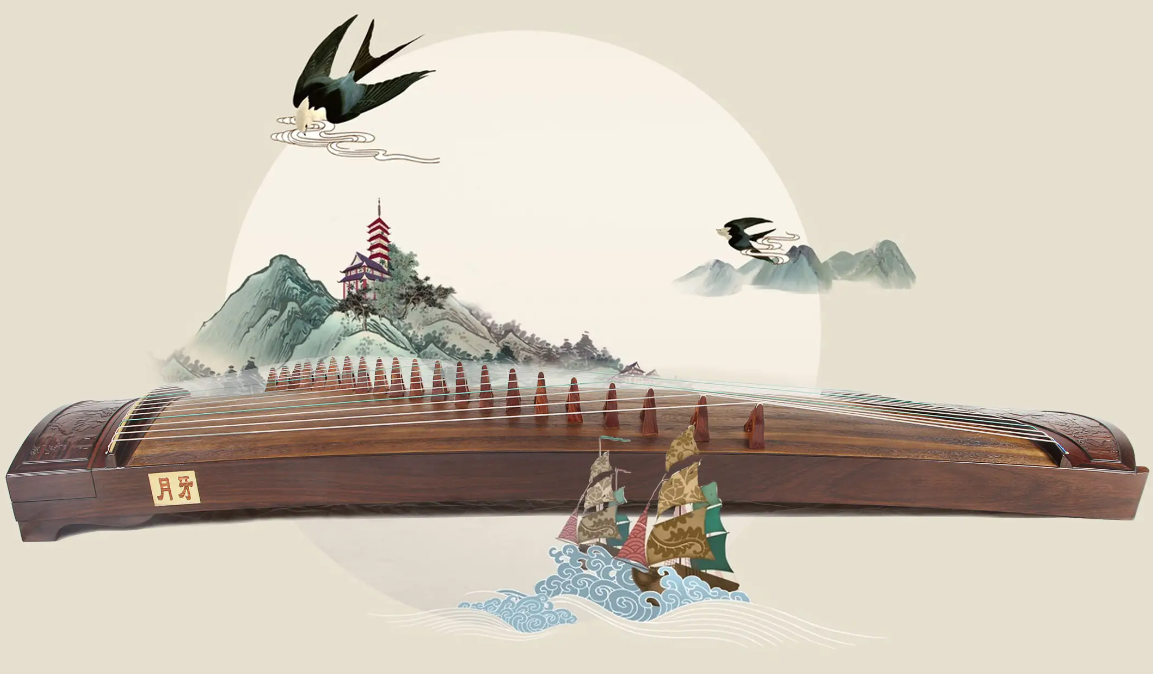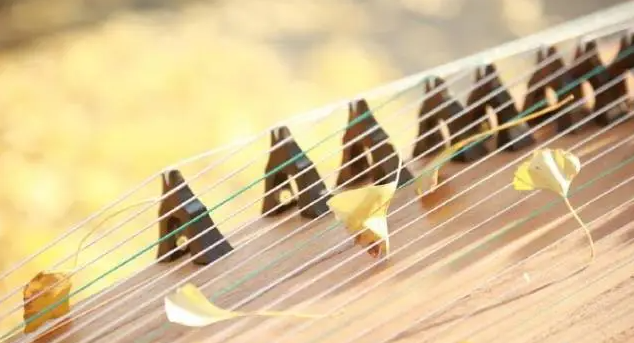Starting from the Origin, Talking about the Similarities and Differences of Guzheng Music in China and Japan
The zheng originated in the Qin Dynasty of our country, and then was introduced into Japan by the Japanese envoys of the Tang Dynasty during the Tang Dynasty. In Japan, the koto gradually spread from the royal court to the people, and it continues to develop. The guzheng music of the two countries is related to each other in the past and present, but also presents different styles and characteristics due to differences in history, culture and geography.
The string system of the zheng has changed a lot in history, ranging from five to sixteen strings. Among them, the 12-string and 13-string zheng are the most widely used in history and have the longest influence. Chinese traditional zheng music, the strings used are the popular 16-string zheng in Ming and Qing Dynasties and the traditional 13-string zheng. The 21-string S-shaped guzheng improved by the Zhejiang Zheng School is widely used in modern times. The material of the zheng is mainly paulownia, and the frame is made of mahogany. The zheng strings are mainly made of steel strings, and the thickness of the strings varies. The sound is crisp, bright, and lingering.
There are three types of Japanese zithers: Le zheng, Zhuzi zheng, and vulgar zheng. Among them, the vulgar zheng is longer in shape, and its shape retains the tradition of the thirteen-string zheng in the Tang Dynasty. Its material is similar to that of Chinese zheng. However, the strings are made of silk strings of equal thickness and nylon strings made of resin.

The tempering system of traditional Chinese zheng music is mainly based on the method of five degrees of mutual generation, and the basic tuning method is the Gong, Shang, Jiao, Zheng, Yu pentatonic scales. The phonemes are arranged as do, re, mi, sol, and la, and the two changing sounds "Qingjiao" and "Biangong" are produced by playing techniques. There are some differences in the rhythm of these two tones in traditional zheng tunes of different schools, but this is also the reason for the different styles of zheng tunes in different places.
The phonemic arrangement of traditional Japanese koto is more complicated. According to the category of zheng, it can be divided into three types: "phonemic arrangement of music zheng", "phonemic arrangement of Zhuzizheng" and "phonemic arrangement of vulgar zheng". The phonemic arrangement of Zhuzizheng is based on the tuning method of the music zheng, and the scale without semitones is formulated according to the temperament scale. The phonemic arrangement of the guzheng is based on the scale of the capital city, which contains semitones. The tuning method of Japanese koto has undergone many changes in the development of traditional koto music. It is not only a symbol of the reform and development of Japanese koto music, but also constitutes the characteristics of the changeable styles of Japanese koto music.
Although the Chinese and Japanese zheng music is mainly based on the pentatonic scale, due to the difference in the ancient rhythm of the two countries, the music created naturally has differences in style. Japanese zheng music has a particularly strong national flavor, while Chinese zheng music has gradually developed, and some creations have been separated from the cultural atmosphere of national music.
In terms of notation formation in China, in addition to today's common simplified notation and staff, there are also historical Gongchi notation, minus-character notation, 24 notation, string sequence notation, etc.
In notation, Japanese koto uses "one, two, three, four, five, six, seven, eight, nine, ten, bucket, Wei, towel" to represent the string positions and sound names of the thirteen-stringed koto. This notation may be closely related to the notation of Ersipu, an ancient notation spread in Chaozhou area of our country.
The range of Chinese zheng is related to the number of strings. The commonly used 21-string zheng is four octaves and a minor third. Generally, the lowest note is D, and the strings are tuned according to the pentatonic scale.
The Japanese koto actually uses only two and a half octaves in the extreme range of four octaves, and at most three octaves. The reason is that the high-pitched sound is relatively stiff and the expressiveness is poor. Give full play to the tension of the strings. When playing hard, it is easy for the zither to fall down, and the zither sticks to the surface of the orange, that is, the panel, and the performance is interrupted. The most effective range of a twenty-string zheng should be c-a2, and the range of a seventeen-string zheng is c-e1 (or g1).

The performance techniques of traditional Chinese and Japanese zheng music are mainly manifested in the form of playing the strings with the right hand and retouching with the left hand. From the perspective of acoustics, the performance skills of traditional zheng music can be divided into nine types: monophonic skills, harmonic skills, arpeggio skills, decorative tone skills, scratching skills, sustained tone skills, portamento skills, vibrato skills and noise skills.
In the category of "monophonic skills", in traditional Chinese zheng music, each technique not only has forward string strumming, but also reverse string strumming. This kind of technique is more diverse than the one-way technique of traditional Japanese koto when it is used comprehensively. Among the "harmony skills", the performance techniques of Chinese zheng music also have forward and reverse performance techniques, while in the "harmonious skills" of Japanese koto songs, one-way performance is also the main technique. "Claw", "Half-Claw", "Early Claw" and so on. From this point of view, the reverse string playing of Chinese zheng has its unique characteristics. A characteristic of traditional Chinese zheng music is also reflected in the "decorative tone technique" and "continuous tone technique", among which the use of ornamental tones is extremely extensive and varied, and constitutes the stylistic technique of zheng music in different cities. In the "scratching technique", the scratching techniques of Japanese koto music should be richer, such as "introduction", "introduction" and other techniques, that is, there are changes in timbre and timing. "Pressing, portamento technique" and "vibrato technique" are important expressions of Chinese and Japanese zheng music, and their appearance forms the characteristic of zheng's "filling sound with rhyme". Therefore, its changes are subtle, not only from place to place, but also from person to person, and it is difficult to fully reflect it in notation. "Noise technique" is a unique technique of Japanese traditional koto music. The pursuit of noise and sound in traditional Japanese koto music reflects the unique musical aesthetic concept of its cultural background.
In the process of its dissemination and inheritance, Chinese zheng music is influenced by many factors such as geography, politics, economy, culture, language and folk customs, especially the integration of folk music from various places. The school of local color gradually formed. In terms of regional characteristics, there are two major factions, north and south, and in terms of specific style characteristics, there is a saying that "the vast nine factions flow in China".

The Japanese koto school is divided into genres according to the historical development of Japanese koto music. In this regard, China and Japan are obviously very different. Because the Japanese koto school is divided according to time, there is not a situation where several major schools "compete for strangeness and beauty". During the Kamakura and Murotoi eras, Kenshun, a monk from Kurume in the Kitakyushu region, organized and innovated the classics that have been handed down, resulting in a new school of music called "Zukushi-ryu". In the middle of the 17th century, the blind Yahashi School inspected the school, learned and inherited the skills of the Chikushi School in Edo, and developed and created it on this basis. In the Genroku era, the Ikuta Examination School in Kyoto used the Diko Shamisen song on the koto and created the "Ikuta-ryu". In the cultural and political era, the Yamada Examination School in Edo adopted the form of jorui shamisen and created the "Yamada-style". So far, two different koto styles of "Ikuta-style" and "Yamada-style" are still preserved.
The musical styles of Chinese zheng music are mainly elegant, poignant and tragic. First, poignant: in the music style, most of the works are of lightness, elegance, stretch, freedom, and gentleness. They often imitate landscapes, chant the natural interest of flowers and birds, and express people's love for nature. It shows the infinite vitality and interest of nature, and brings people an aesthetic feeling of serenity, leisure and peace. Here, people can cleanse their minds in the melody and hear the sound and get close to nature. Second, poignant: extremely emotional impact and explosive. The music works are grand in structure, ingenious and complex in form, and rhythm is fast and slow. In particular, the works depicting the mood and emotions of ancient women give full play to the advantages of guzheng in expressing rhythm. Third, tragic and solemn: it wins with its momentum, and its magnificent and spectacular appearance is reflected in the length of the music, the form of the music, the arrangement of the structure, the sound effect, the performance technique, and the dynamics of the melody. Magnificent musical works often use a narrative method, with great emotional tension, and the melody has a very obvious dynamic. These works can simulate violent storms, and can depict people's cheerful and enthusiastic labor scenes, including a kind of praise and affirmation of life.
The characteristics of Japanese koto music with short reverberation, hard string system and wide string spacing limit many possibilities for the development of vibrato skills and decorative tone skills, while the rich and colorful vibrato vibrato and decorative tone skills of Chinese koto songs have become a feature that distinguishes many traditional kotos. An important symbol of the music genre. The common traditional performance form of Japanese koto is self-playing and self-singing, accompanied by zheng songs, so that the subtle illusion of musical expressions is concentrated on the long and melodious vocal melody, which is sung and three sighs. At the same time, the extensive use of noise skills is also in this performance. An inherent need for formal music aesthetics.
Chinese and Japanese zheng music is related to the same origin. The Chinese Tang zheng system, string system, playing technique, performance form, as well as tonal mode and music style structure provide a foundation for the development and progress of Japanese zheng music. Chinese and Japanese traditional zheng music performance skills The many differences are the inevitable result of the Tangzheng entering Japan to adapt to its unique musical cultural background. The obvious reason is that the Japanese zheng has many differences in the use of shape materials, temperament, mode, tuning method and performance form. As a result, the Japanese koto's acoustic characteristics, performance performance and music combination methods are different, and the requirements for performance skills are naturally different.
 渝公网安备 50010702504639号
渝公网安备 50010702504639号